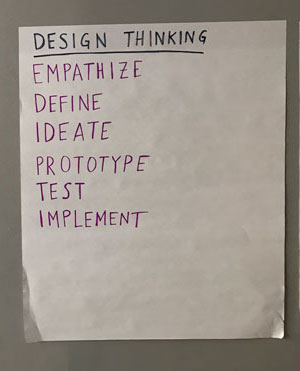Design thinking is not a complicated process, but your workshop participants may not be familiar with it. Even if they have heard the term, or have a general idea, it still helps to have a reminder and break down the steps in a way that will be relevant for them and the project at hand.
The facilitator's introduction to the process should be short – 15 minutes or less. It's more important to get participants to learn by doing. At the beginning of each exercise, you may want to point out where you are in the process (having some diagrams you can point to in the room can be useful). Design thinking needs to feel relevant for users; your role is to help connect the dots and create an environment that lets these concepts come to life.
Introduce the process
As you present the process, give a quick definition of what it involves. Whether it's a diagram or simple poster, make sure to use a visual reference.

An introduction can to go something like this:
EMPATHY is the key foundation of design thinking. You want to understand users and customers from their perspective - their environment, behaviors, motivations, and choices. In order to gain empathy, you need to get out from behind your desk in order to observe and talk to people in their context.
In the DEFINE phase, we'll be looking at what problem we want to explore. This will be inspired by the research and discoveries from the first phase. Another way to think of this is re-framing the problem or opportunity.
In the IDEATION phase, you'll come up with TONS of ideas, even if they seem a bit "out there." Then you're going to pick one concept to PROTOTYPE. Before turning to the computer, look to create something tangible to explore how your ideas may come to life.
In the TESTING phase, you'll look for feedback from users. From there you'll iterate and make improvements on your prototype. Throughout the process, you'll revisit different phases depending on the project, before you ultimately IMPLEMENT the creation.
Multiple approaches, same ideas
Every organization has its own variation on the design thinking process, but the same general principles apply. Using a short video can be helpful when introducing people to the process and for you to develop your own preferences when guiding others through the process.
Check out these explanations:
The Design Thinking Process [3:52 min]
What is Design Thinking? uses different phases, but the same ideas are communicated. [4:20 min]
FHIL's Stages of Design Thinking provides an entertaining look at the process while drilling in key concepts. [8:41 min]
Mini challenge
Describe a design thinking process for a group. Sketch out what visual you plan to use. How will you put your own spin on it? Write out how you will introduce each part of the process.
Let's recap!
Present the design thinking process at the beginning of each workshop. Don't assume everyone knows what it is or how it will be used in the context of the workshop you're hosting.
Give participants a background on design thinking as well as resources they can use to learn more.
Decide how you want to present the process: slides, large posters, handouts, etc.
